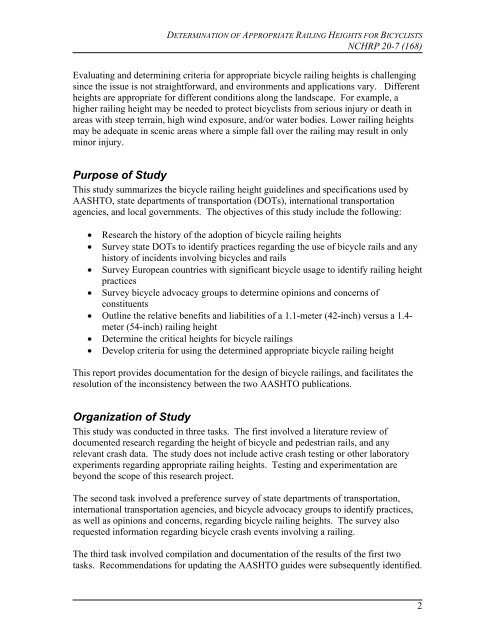Bicycle Railing Height Report - AASHTO - Subcommittee on Design
Bicycle Railing Height Report - AASHTO - Subcommittee on Design
Bicycle Railing Height Report - AASHTO - Subcommittee on Design
Create successful ePaper yourself
Turn your PDF publications into a flip-book with our unique Google optimized e-Paper software.
DETERMINATION OF APPROPRIATE RAILING HEIGHTS FOR BICYCLISTS<br />
NCHRP 20-7 (168)<br />
Evaluating and determining criteria for appropriate bicycle railing heights is challenging<br />
since the issue is not straightforward, and envir<strong>on</strong>ments and applicati<strong>on</strong>s vary. Different<br />
heights are appropriate for different c<strong>on</strong>diti<strong>on</strong>s al<strong>on</strong>g the landscape. For example, a<br />
higher railing height may be needed to protect bicyclists from serious injury or death in<br />
areas with steep terrain, high wind exposure, and/or water bodies. Lower railing heights<br />
may be adequate in scenic areas where a simple fall over the railing may result in <strong>on</strong>ly<br />
minor injury.<br />
Purpose of Study<br />
This study summarizes the bicycle railing height guidelines and specificati<strong>on</strong>s used by<br />
<str<strong>on</strong>g>AASHTO</str<strong>on</strong>g>, state departments of transportati<strong>on</strong> (DOTs), internati<strong>on</strong>al transportati<strong>on</strong><br />
agencies, and local governments. The objectives of this study include the following:<br />
• Research the history of the adopti<strong>on</strong> of bicycle railing heights<br />
• Survey state DOTs to identify practices regarding the use of bicycle rails and any<br />
history of incidents involving bicycles and rails<br />
• Survey European countries with significant bicycle usage to identify railing height<br />
practices<br />
• Survey bicycle advocacy groups to determine opini<strong>on</strong>s and c<strong>on</strong>cerns of<br />
c<strong>on</strong>stituents<br />
• Outline the relative benefits and liabilities of a 1.1-meter (42-inch) versus a 1.4-<br />
meter (54-inch) railing height<br />
• Determine the critical heights for bicycle railings<br />
• Develop criteria for using the determined appropriate bicycle railing height<br />
This report provides documentati<strong>on</strong> for the design of bicycle railings, and facilitates the<br />
resoluti<strong>on</strong> of the inc<strong>on</strong>sistency between the two <str<strong>on</strong>g>AASHTO</str<strong>on</strong>g> publicati<strong>on</strong>s.<br />
Organizati<strong>on</strong> of Study<br />
This study was c<strong>on</strong>ducted in three tasks. The first involved a literature review of<br />
documented research regarding the height of bicycle and pedestrian rails, and any<br />
relevant crash data. The study does not include active crash testing or other laboratory<br />
experiments regarding appropriate railing heights. Testing and experimentati<strong>on</strong> are<br />
bey<strong>on</strong>d the scope of this research project.<br />
The sec<strong>on</strong>d task involved a preference survey of state departments of transportati<strong>on</strong>,<br />
internati<strong>on</strong>al transportati<strong>on</strong> agencies, and bicycle advocacy groups to identify practices,<br />
as well as opini<strong>on</strong>s and c<strong>on</strong>cerns, regarding bicycle railing heights. The survey also<br />
requested informati<strong>on</strong> regarding bicycle crash events involving a railing.<br />
The third task involved compilati<strong>on</strong> and documentati<strong>on</strong> of the results of the first two<br />
tasks. Recommendati<strong>on</strong>s for updating the <str<strong>on</strong>g>AASHTO</str<strong>on</strong>g> guides were subsequently identified.<br />
2


